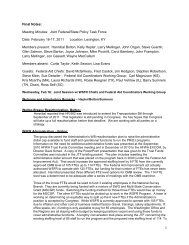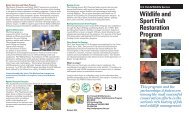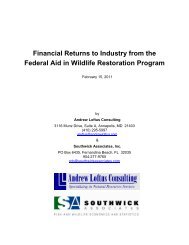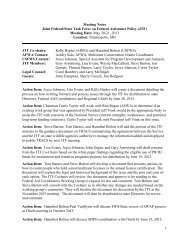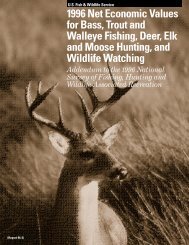Program Update - Wildlife and Sport Fish Restoration Program - U.S. ...
Program Update - Wildlife and Sport Fish Restoration Program - U.S. ...
Program Update - Wildlife and Sport Fish Restoration Program - U.S. ...
You also want an ePaper? Increase the reach of your titles
YUMPU automatically turns print PDFs into web optimized ePapers that Google loves.
UDWR biologists, l<strong>and</strong> management personnel from the USFS <strong>and</strong> BLM, <strong>and</strong> private<br />
l<strong>and</strong>owners use the range trend database to evaluate the impact of l<strong>and</strong> management<br />
programs on elk <strong>and</strong> mule deer habitat. Range trend data are used by wildlife<br />
biologists <strong>and</strong> other l<strong>and</strong> managers for habitat improvement planning purposes,<br />
reviewing BLM <strong>and</strong> USFS grazing allotment management plans, <strong>and</strong> as one of several<br />
sources of information for revising deer <strong>and</strong> elk herd management plans. Results of<br />
the annual survey work are readily available to partners via report <strong>and</strong> the Division’s<br />
Web site. Early detection of vegetation changes have allowed resource managers to<br />
make necessary adjustments before habitat damage was out of control. For example,<br />
during 2002-04 drought conditions caused the die off of several st<strong>and</strong>s of Wyoming big<br />
sage brush. Data from the range trend studies allowed managers to determine which<br />
areas required habitat improvement.<br />
<strong>Sport</strong> <strong>Fish</strong><br />
<strong>Restoration</strong><br />
Whirling Disease “Resistant” Strains of Rainbow Trout Reproducing Naturally in<br />
Colorado<br />
A Project Funded by Colorado Division of <strong>Wildlife</strong> <strong>and</strong><br />
U.S. <strong>Fish</strong> <strong>and</strong> <strong>Wildlife</strong> Service<br />
For the first time since whirling disease decimated most naturally reproducing<br />
rainbow trout populations throughout Colorado more than a decade ago, new strains<br />
of rainbows have reproduced naturally in the Gunnison River <strong>and</strong> in ponds located<br />
along the Frying Pan River near Basalt, Colorado.<br />
Colorado Division of <strong>Wildlife</strong> (CDOW) biologists are hopeful that the successful<br />
natural reproduction will lead to re-establishing wild, self-sustaining rainbow trout<br />
populations in Colorado where whirling disease has precluded wild rainbow trout<br />
recovery efforts. The fish, a cross of the Hofer rainbow trout <strong>and</strong> other rainbow<br />
strains that are used for stocking, appear to be resistant to whirling disease.<br />
The Gunnison River is lower in elevation, water temperatures are warmer <strong>and</strong> it is<br />
renowned for producing large trout. Brown trout, which are resistant to whirling<br />
disease, thrive in the river. The ponds on the Frying Pan River also provide relatively<br />
warm water.<br />
George Schisler, a CDOW aquatic research scientist, said the next best milestone<br />
will come in late 2008. “The fish need to make it to age one <strong>and</strong> beyond, so we’ll see<br />
this fall,” Schisler said. But judging from research conducted on the Hofer strain,<br />
scientists are confident that the fish will survive <strong>and</strong> continue to reproduce.<br />
42 <strong>Wildlife</strong> <strong>and</strong> <strong>Sport</strong> <strong>Fish</strong> <strong>Program</strong> <strong>Update</strong> September 2008




